Gandhi & Hitler - Goodness & Evil In My Memory
Saturday, March 07, 2009

Seeing the lovely evocative still life pictures, in the newspapers, containing some of Mahatma Gandhi’s personal items that went up for auction this past week reinforced my concern about my wife telling me a few weeks ago that, “I was no longer for this world,” as I thought too much about the past. Rosemary increasingly feels that I don’t fit much in my present. Jokingly asking Hilary, my youngest daughter (at the dinner table) last Monday if she could obtain a large bottle of sleeping pills for me was not taken as a joke and I was received with ice-cold silence. Even Rebecca (Hilary's daughter) caught on.
The pictures of Gandhi, his pocket watch and glasses made me think of my past, of my wife Rosemary and of my mother. In that hazy era of my life in the late 40s when I was under 10 my mother had introduced me to evil when she had noted that when my hair fell over my eyes I looked like Hitler. “Who is Hitler?" I had asked. “He was an evil man," she answered. And I first heard of goodness from her, too. Often when I misbehaved she would tell me that I should try to be good like Mahatma Gandhi. I have visions of b+w newsreels showing the British leaving India. As soon as the Indians opened their embassy in Buenos Aires my father did translation work for them. He even had the audacity to invite some of his Indian friends home to sample his curry.
During the middle ages and the renaissance, painters and sculptors worked on commission. Their portraits and sculptures were for wealthy patrons or purchased to decorate the churches of a wealthy Catholic church. It is only with war that these paintings and sculptures changed hands. Napoleon looted the treasures of Venice and Egypt, the Spaniards looted the Lower Countries and the works of art then changed hands from the Spanish kings to the Prado Museum. The British expropriated the treasures of Greece and other parts of their far flung empire. The idea of seeing a work of art on a gallery wall is a relatively modern phenomenon. The few paintings that remained in private hands (after museums secured most of them) have changed hands in the latter part of the 20th century and in the beginning of this one for huge sums of money. When paintings just about disappeared, auction houses “discovered” the works of photographers and as an example, the photographs of American Edward Steichen. One of his prints sold for millions recently. With so many rich people in the world, exclusivity and power are the only ways to rise from wealthy anonymity. With few paintings, sculptures and exotic cars like Duisenbergs left, people with money now achieve exclusivity by collecting fame or infamy. Fame, Gandhi’s glasses, infamy a Hitler watercolour. O.J. Simpson’s white Ford Bronco will surely be snapped up for lots of money in a not-so-distant future.
This trend to collect the trappings of fame is no different from the medieval one to secure the bodies or parts thereof saints. The Venetians in 828 ‘kidnapped” St. Matthew’s body from under the eyes of Egyptians in Alexandria.
The trend to search for fame has brought us all those homes and hotels with signs that say, “Martha Washington slept here,” “Alexander von Humboldt wrote here," "Oscar Wilde was caught in the act of ...here," and the like.
Our memory for history is certainly longer than for the history of our own lives. In the early 70s Rosemary asked my mother to write (with a white pen) the names of her relatives and my father’s with dates in our photo album. Death to me has always been staring at me from the pages of my family album. If some of those faces have not been identified by my mother I do not know who they are. Therefore they are finally dead. They are dead in the vacuum of my memory. I expect my picture to stare back at some descendant of mine in a near future (two generations is all it takes) who will stare and draw a blank.
In the still life here I have placed on my scanner a letter I received from my girlfriend Susy in February 1966 who was vacationing in the resort town of Pinamar. We got to know each other through these letters and finally managed to get a weekend at the Naval Ministry off and I hitchhiked to Pinamar where we met on the beach. So romantic, so long ago it was. Susy is dead and I have a few of her letters and some memories. Would anybody care to read the letters now? I don’t think so. Will Rebecca and Lauren find them fascinating when they are older? I doubt it. Should I keep them? I do, because I don’t have the heart to throw them away or to burn them. The little scissors and the gold eyeglasses belonged to Rosemary's grandmother. The Longines watch I won at cards in the late 60s. They have an intrinsic value to Rosmary and to me, now.
Ultimately the difference between ordinary mortals and celebrities like Gandhi is time. Time in the end brings us all an oblivion we all democratically share. Meanwhile as we get older and we are surrounded by all these objects of our past, parting with them is an anguish almost too terrible to bear.
A Serious Dean Paul Gibson Makes Jessie Richardson Smile
Friday, March 06, 2009
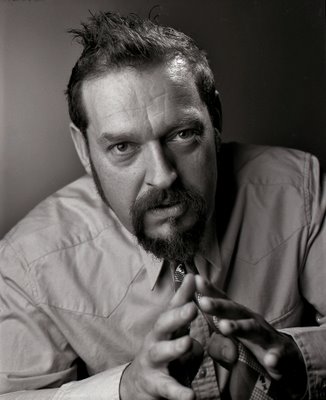 In the fall of 2008 I had the good fortune to photograph two very good Vancouver theatre directors who happen to be friends. I photographed Bill Millerd, Artistic Managing Director of the Arts Club Theatre Company with his counterpart of Bard on the Beach, Christopher Gaze. I told them both of my excitement of also having to photograph another of my favourite directors, Kim Collier of the Electric Theatre Company. I had seen her direction, an Electric Theatre Company production of Jean Paul Sartre’s No Exit. My wife Rosemary is rarely pleased by anything and she thought No Exit was terrific. At that point Millerd told me that his company had commissioned Collier and her company to work on a project for him. Not to be left without saying anything, Gaze told me, “And we also have another talented young female director, besides Collier in our Titus Andronicus. Meg roe is doing The Tempest for us. She is extraordinary.” With Gaze’s diction and voice I was already awed. 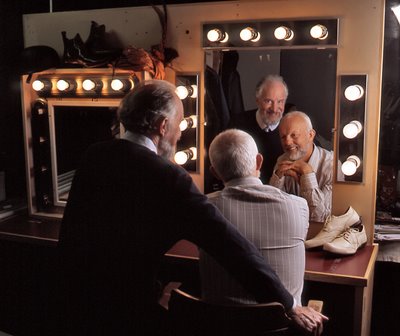 But not as awed as I was last night when Rosemary and I went to see the Joan Macleod play Toronto, Mississippi, a Playhouse Theatre Company production directed by Dean Paul Gibson, another director and actor who has paid his dues in full for both Bard On the Beach and the Arts Club Theatre Company. I have seen this funny actor direct dead serious plays and funny plays but I had never seen him direct a dead serious & funny play. It is almost superfluous for me to mention that Rosemary thinks Dean Paul Gibson is fantastic and even pointed out his spiffy new attire, (so English!) that he was wearing last night at the intermission. “And he has even lost weight, “she duly informed me. It would seem to me that he probably lost 15 pounds just in the rehearsals of this terrific play and shows that he has a gentle and non intruding touch when necessary. After all he had three very good actors, Alessandro Juliani, (Bill) William MacDonald (King) and Colleen Wheeler (Maddie) at his disposal. It was the fourth, Meg Roe who delivered fully in spades. I wonder how Gibson managed to coax (Was that indeed the case?) that performance (It could not possibly have been only that, could it?) from Meg Roe? My first impression was (I had not read the program as I like to be surprised and like the challenge of figuring out a play on my own) that the actress on stage was autistic. Maddie (Colleen Wheeler) her mother erroneously speculates that it was caused by oxygen deprivation at birth. It took me a while to understand that I was watching a performance that only (and only perhaps ) someone like Sissy Spacek, her look-alike, could have delivered. It is not often that as I watch a play I forget that an actor is acting. The other three actors were very good (in particular Alessandro Juliani's believable warmth and understanding of a young girl's mental deffects) they were actors acting. Meg Roe was Jhana. I have a feeling that Dean Paul Gibson must have just given her the floor to do as she pleased. As I watched Alessandro Juliani I thought of a friend, novelist and writer John Lekich. He, like, Meg Roe’s Jhana, may have suffered oxygen deprivation at birth. Rosemary asked me, at the end of the play, “What must it be like for a parent to have a girl like that? How would they take coming to a play like this? ” I said nothing as I was thinking of Lekich and his admiration for Alessandro’s father John whom I never had the luck to photograph. I can see the physical resemblance. When John Juliani was alive he was Vancouver's most handsome man. I wonder if Lekich will have the curiousity and courage to go to this play should he read this?  If Meg Roe does not receive a Jessie Richardson for her performance I am sure that Jessie Richardson, right, might just stop smiling for a while. As we left I ran into actor Marco Soriano and I commented, "Meg Roe can act and direct." Soriano countered, "And sound design, too!" Toronto, Mississippi continues until March 21 at the Playhouse.
Haven Saves A Loss
Thursday, March 05, 2009
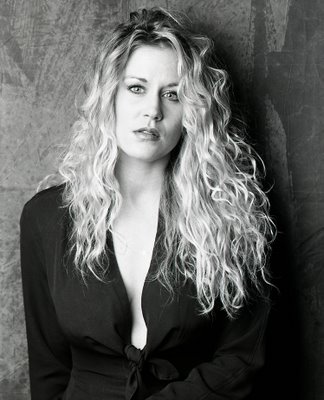 A few months ago a good client of mine, a criminal law firm called me up for a job. It was an important job and when the lawyer decided on the pictures and gave me a call I went to look for the file. I could not find the pictures which were 6x7 cm transparencies. I looked everywhere an in particular those piles that the paperless digital revolution reneged on. My next step was to go to my diary and see what other jobs I may have done at the same time and perhaps I had inadvertently inserted the law firm’s pictures with them. That got me nowhere. By this point I was desperate. I told Rosemary, “If these guys choose to sue me we are going to be in serious trouble. They are very good.” I went into the living room (where I keep my computer on a fine Edwardian desk overlooking my garden). Then I looked at a pile of big heavy books on a table. I have run out of space for books in my bookshelves so I put books on tables and place them (as neatly as I can) on piles on the floor. I rushed to the big heavy books as I remembered what I had done with the transparencies. Of late my film processor, the Lab has been having problems with film curl. It does not happen with Japanese films but it seems to plague Kodak Ektachrome and one faithful user. That’s me. In order for me to scan these transparencies I must place them under heavy books for a day or two to flatten them.  Today the scenario repeated itself but this time I have no magic bullet and my memory fails me as I have looked for the pictures of another law firm (personal injury). I took them a year and a half ago. I kept the high resolution scan files in my computer until about two months ago. Then I purged them knowing I have the originals safely filed. That is not the case. I have spent long hours going through all the different kinds of misspellings and variants to the firm’s name. It would take many weeks to look into every file (about 12 four-drawer filing cabinets full of stuff). While looking for the pictures in those files on the floor (I always seem to be behind in my filing) I found a Polaroid of a luscious blond. I thought and thought of her name but my memory was frazzled. It finally came. I remember the day some years ago. It has to be at least 15 years since the background is a hand painted brown canvas backdrop. They had been in vogue in those days although by then their popularity was in decline. Tony Ricci had called me one day. “Alex I want you to do me a favour. I want you to photograph a girl I know. She has a young daughter. She is a bit lost. Maybe she can model. Please take her picture for me. Her name is Haven.”  I did. In my files under Haven I found exactly 9 b+w images. I don't recall why it is that I took so few. Nine pictures and one Polaroid, that's all there is of Haven. I called her weeks later and delivered my contacts to her. At the time she was working as a hairdresser in a very nice downtown salon. I never heard from her again. Today Haven made my day. Addendum Late today Thursday with my mind relaxed after gazing at the calm beauty of Haven I can report that I have found the lost transparencies.
Exotic Russian Ladas & Living Edward S. Curtis Photogravures
Wednesday, March 04, 2009
 When I visit Alleyne and Barbara Cook’s North Vancouver garden in June I automatically rush to gaze and smell a Damask rose called ‘Ispahan’. It was brought to Europe in the XIII century. Named after the ancient city in Iran this wonderful rose transports me into the exotic times, and places of the stories of Scheherazade. The last thought in my mind as I take in the wonderful fragrance of this pink rose is a huge building with thousands of spinning centrifuges enriching uranium to atomic bomb grade.
In the late 50s and even into the 60s I would often take a look at the bottom plate of my Pentacon F 35mm SLR and read with wonder, embossed on the strip of real black leather, Made In USSR Occupied Zone. It wasn’t too long ago that if I spotted a clunky Russian Lada I would stop and stare and examine its metal as if steel from the USSR were as exotic as the rings of Saturn.
My vision of Mexico in the 50s was of Aztec priests ripping open the chests of beautiful dark Tlaxcalan virgins with an obsidian knife and tearing out the still palpitating hearts that were then offered to that nasty and blood-thirsty war god Huitzilopochtli. I had no vision of white sandy beaches and piña coladas.
Before you could order chili-avocado sushi at a Tacubaya Starbucks in Mexico City, the exotic for me was the remote, the romantic and the unknown. The world for me was a plate of roast beef, mashed potatoes and salad on one plate, but all in their separate sector. I was careful that the gravy would not spread in the direction of the salad. As the world has become more the same in a globalized blend there is little left that is exotic.

In 1999 I was assigned to photograph five female Native Canadian filmmakers. Alas, the one I knew, Dana Claxton was a no show. The four that showed up at my studio (on separate days) were like Ispahan roses. I was in awe of them. I had never been this close to a Native Canadian except for a few snaps of Chief Dan George many years before at a CBC variety show.
When Loretta Todd opened a box that contained a turquoise necklace, its colour made me think that I was on acid (an experience of my imagination since I never touched the stuff).

But it was when Arlene Bowman, a Dine (Navajo) from Phoenix, Arizona came into my studio that I thought I was staring at a living and breathing Edward S. Curtis photogravure. I had to photograph her in profile. I was magically transported back in time.
Now in the year of 2009 I search for the wonder of the exotic. Should I run into a blank, June is around the corner and Rosa ‘Ispahan’ beckons as I think of sipping cool pomegranate juice while being told wondrous stories by a beautiful veiled maiden.
Native Canadian Princesses
Photogravure
More Photogravures
My Pentacon F
Tuesday, March 03, 2009
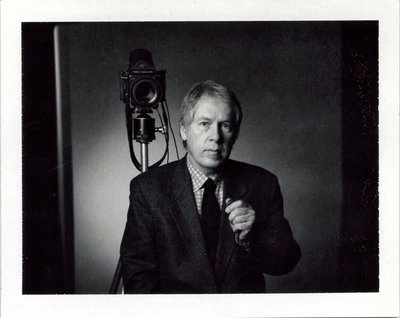 I received a polite notification yesterday from VLM/myvancouver editor/art director/publisher Bob Mercer (left) that he was ceasing publication of his magazine just about when the third incarnation of myvancouver was to appear on selected Vancouver doorsteps. From my initial collaboration with Mercer in March 2007 I grew to like a man who had a vision to dream against all odds. I kept thinking to myself, "What does this man know about magazines that in my 35 years of working for them I don't know?" Had he really asked for my advice I would have told him, "Don't mortgage your house, don't launch this magazine. You will not succeed." I was critical of his efforts, but only marginally so as I wanted to keep my ability to dream. With Mercer's VLM I could dream about anything and somehow find a way of getting his positive nod, my execution of the assignment as both a written and photographic piece, and then anticipate the days until I would see that dream on the cover of VLM or prominently displayed inside with an elegant design and exquisite reproduction of my images. While I was dreaming I was silently telling myself, "Mercer, you are a fool to hope that Vancouverites will embrace a good magazine in an age of aggregators that compile bad blogs about boring issues that are regurgitated from a declining media base that is replacing professional journalists with amateurs." Ours is not an age of citizen journalism but one I would better call amateur journalism. The word amateur as used by the British of the 19th century denoted men (mostly men) and women who eschewed profit to embark on causes such as archeology, anthropology, botany, exploration, etc with a deep reverence and passion. These amateurs are a far cry from the amateurs of today who give us opinions on anything just because they can press and send. "And even if you are a fool, Mercer," I kept thinking, "don't quit now. Give me room to dream. Give me room to think of people I would like to photograph and write about. Give me the opportunity to photograph Vancouver's most beautiful woman, Gloria Macarenko, give me the opportunity to photograph my friend Sean Rossiter with one of his model airplanes, give me the chance to photograph those wondrous ballet boys from Arts Umbrella and explore why they have a passion for dance." Mercer was foolish enough to keep his magazine going while I dreamt and dreamt to my heart's content. With VLM/myvancouver gone, my capacity to see my dreams as real (the very reason why as fourth kind of fool I chose 35 years ago to become an editorial photographer) has now been diminished to just about zero. My only comfort is that Mercer, in spite of being a fool, had a great capacity to dream. Mercer may have failed (he vows he will return in the fall) but I wonder if failure in such things is not amply compensated by that long run of dreams? Three Fools & Gloria Macarenko Monday, March 05, 2007 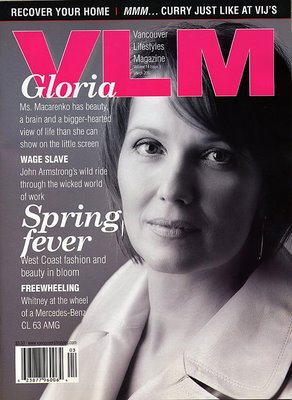 I have observed three fools in action over the years and when they finally give up there are many more of the type to occupy their place. These fools have the ambition to: 1. Publish and or edit a magazine, tabloid or newspaper. 2. Start an art gallery. 3. Open a restaurant. It was quite a few years ago that Urban Peasant, James Barber had to withdraw from his Commercial Drive restaurant venture Arriva. He was losing his shirt. But he went on the record in a magazine article, how the experience had not turned him off. He asserted that when the opportunity rose he would start a restaurant again. Dianne Farris once told me that she had not only mortgaged her house away to keep her gallery going but that she was also painting herself into a plumbing corner as the bathrooms did not work. But she was going to press on with her dream. I think it is the dream that keeps these three "fools" going. You have an idea, and reality (with its instant satisfaction) can be quick in coming if you publish a weekly or a daily. I have been privy to conversations between publishers and editors where the former would swear a no inteference policy so as to keep an editorial independence. And I have seen these promises disappear as "service" peaces became the norm for keeping a magazine afloat. As a photographer I have been promised more times than I can possibly remember, "This is a new magazine and we can only afford this much, but as soon as we become more successful we will pay you what you are really worth." I have seen young photographers, illustrators and freelance writers be given "photo" or "writing" credits instead of hard cash. I have never had the heart or the gumption to tell them that money will never come and photo credits are not proper collateral at the bank. But would be gallery owners, restauranteurs and publisher/editors keep passing by my horizon and for the latter I am almost never able to say, "No," when asked to help out for little or no money. Could it be that I am a dreamer, too? The prospect of seeing a magazine with my cover photo has always been an exciting delight. My latest effort is no less a delight. It was about a month ago that experienced editor/art director Bob Mercer told me he had the project to re-brand the most horrible (my word) magazine in Vancouver. 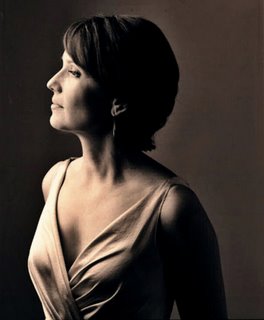 He said he wanted to turn around Vancouver Lifestyles Magazine (now called VLM)and wanted bold b+w covers. Best of all (this is how he lured me in) he wanted me to suggest who was the person I would want to photograph the most. My answer was an easy one. I photographed the luminous Gloria Macarenko assisted by my secret weapon of so many years, stylist Maureen Willick. When the magazine appeared last week I could not believe, that just for once, the spread looked better than I had imagined it. I can only hope that editor/art director Bob Mercer's dream comes true.
No Smiles For The Reverend Dodgson Or Brother Stanley Repucci
Monday, March 02, 2009
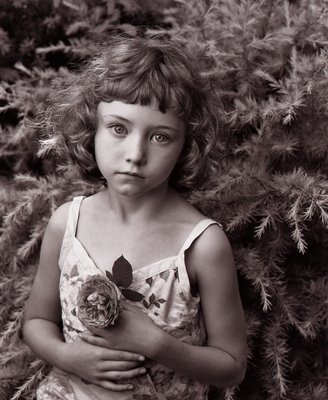
As the change in how the world and in particular those in Vancouver view photography, its purpose and its attraction I find that what I do is no different from re-gapping sparkplugs. It seems to me that my portrait photography is as obsolete as that skill (I was pretty good at it) of adjusting the gaps of the four sparkplugs of my Mexican VW beetle. After cleaning them and adjusting that gap with my precision gap tool I would take the VW up a hill and listen for engine hesitation. I would stop to rotate the distributor a bit in one direction or the other until the engine sounded just right.
For the 11 years that I have been taking portraits of my granddaughter Rebecca I have been criticized by the family for not making her smile. The first picture here, one that I took in 2004, is my favourite portrait of Rebecca. I have a beautiful 16x20 inch print, nicely framed on the wall next to my bed. When I wake up in the morning or before I turn off my reading light at night I look at it and my heart aches at her beauty and that look on her face.
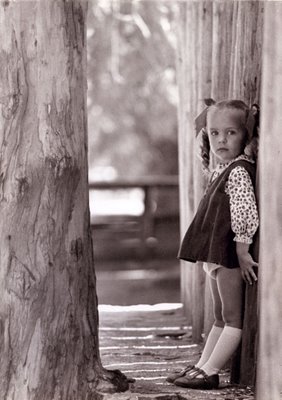
On my first year at the Catholic boarding school in Austin, St Eds (1957) there was a curious Catholic brother, curious because he could alternate friendliness with a cold, almost nasty seriousness. I was scared of him. His name was Brother Stanley Repucci CSC. Our nickname for him was “The Fat Sh..”. Brother Stanley had a fondness for pizza and he would go by all the school dormitories on Friday or Saturday evenings recruiting boys who might want to accompany him for pizza. In those days pizza joints came with red and white checkered table cloths with wicker Chianti bottles with candles. When I had the money, this was infrequent, I would tag along. Brother Stanley taught me to crave pizza at all times.

Brother Stanley taught physics and biology. He had a busy schedule as he headed the school’s rifle, bowling team and the Boy Scouts. He was always surrounded by young boys as he was in charge of the Cubs that were in the 8th grade.
Brother Stanley was tough and he never ever had any kind of discipline problems. It was Brother Stanley who concocted ways of making us excel in his classes promoting competition in unusual ways. Once, in our biology class, he asked us to open up some frogs and sew them back together. The boy, whose frog survived, would get a prize. More often than not the prize was a box of cigars. I think that because of it few of us ever smoked. Brother Stanley understood the mind of boys.
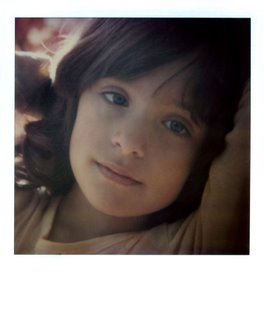
In our innocence and naivety we never thought that Brother Stanley had any kind of ulterior motives for his interest in us. In fact in my four years of boarding I was never aware of any scandal of any kind. Even in those days when we talked to prefects and our Brother teachers in their rooms the doors were kept open.
Brother Stanley died some years ago and his picture in the school web site lists him as Mr. Stanley Repucci. I found that odd and I wondered. But my fellow classmate and distinguished law professor at St. Mary’s University at San Antonio, Lee Lytton III and I both agreed on the reason. Brother Stanley left the order, got married and had children of his own.

There are many who think that the Reverend Charles Lutwidge Dodgson (Lewis Carol) may have had an unhealthy relationship with Alice Liddell. Both Lytton and I believe that Dodgson and Brother Stanley had a healthy love of children. They loved to inspire, entertain and nurture them. Brother Stanley and the Reverend Dodgson treated children as adults. In this century we are too rapid to judge and think the worse of people. The idea of a healthy love for children that is not a motherly or fatherly one is suspect. I guess I am almost safe when I take pictures of Rebecca as an adult because I am the grandfather.
The most useful advice (it felt brutal at the time) I have ever received from anyone came via Brother Stanley. I had decided to drop his physics class. It was too difficult and I did not want a low grade in the course to affect my high average. With that scary face of his (when he was serious) he looked at me squarely in the eye and told me, “It is hard to quit. It is hard for you to quit now. But you will find that it becomes easier when you practice. One day you will be an expert quitter.” I have never forgotten and when possible I have stuck to my guns.
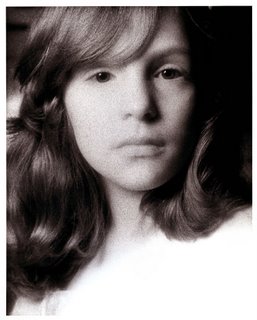
I don’t think I ever baby talked to Rebecca and when she faced my camera I gave her no instruction. I respected her for what she was and is, a little adult. I have taken her to ballet and dance with somewhat adult material and I have spoken to her candidly about stuff that would have shocked her other grandmother. But I feel that Brother Stanley’s guidance is the correct way to educate a young person.
When my daughter Alexandra was 14 she was going through some rebellion. She was sometimes rude and uncommunicative. I decided that I needed to make a father and son road trip, even if she were my daughter and not my son. I had a, bright blue Fiat X-19 mid-engine sports car. I bought Bruce Springsteen’s The River, removed the top from the car and headed with Ale to San Francisco via the coast highway. On our first night we arrived somewhere in Oregon (note the picture of Ale by the Oregon coast, below). We went into a motel and the man behind the desk looked at us in disgust. It suddenly occurred to me what the man thought. How could I correct the situation? I knew how. I loudly told Ale, “Call your mother, if not she is going to worry.” The man looked at me with derision and threw the room keys at me. It was only then that I began to understand that people think the worst and that an extension of this would be my unsettling (to them) portraits of Rebecca not acting like the child that people perceive her to be. The world needs cameras that are pre-programmed to sense big smiles. That need has been recently filled.
Rebecca’s mother, my younger daughter Hilary is most often smiling. A great many of the pictures that I took of her through the years find her smiling, smiling with my mother’s and my crooked smile. But the pictures of her sister are another matter. There are many pictures that seem to be precursors of a style that I would learn to hone with Rebecca.
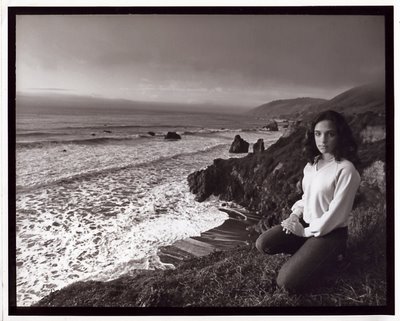
I think of Brother Stanley and how serious he was but how he could also be jovial. If he were to look at my pictures of Rebecca I am sure he would seriously hand me a box of cigars. And he would then smile.
Alexandra Elizabeth's Happy Melancholy
The Serious Ones
Sunday, March 01, 2009
1869
The Personal History And
Experience Of
David Copperfield The Younger
Chapter 1
I am Born
Whether I shall turn out to be the hero of my own life, or whether
that station will be held by anybody else, these pages must show.
To begin my life with the beginning of my life, I record that I was
born (as I have been informed and believe) on a Friday, at twelve
o'clock at night. It was remarked that the clock began to strike,
and I began to cry, simultaneously.
Charles Dickens
One of the most enthralling short stories I have ever read is Alejo Carpentier y Valmont’s Viaje a La Semilla (Journey Back To The Source) (1943). I have found the complete story in Spanish in many sites but the only copy in English that I can secure is residing at the UBC Library where they have all of this Cuban author’s output both in English and in Spanish. My $100 annual fee has lapsed so whoever wants to read this delightful story written with time going backwards, will have to do so in Spanish. The story ends with the nails of a brigantine anchored in a Cuban port, zooming away to the iron mines from whose ore they were extracted and the ship's oak planks flying away to a distant forest from whence they came.
Time has been on my mind of late and in particular my abhorrence for linear time. We moved to our present home in 1986 and our bed is exactly where it was then. I remember our first night after I placed our recently purchased French antique clock on the fireplace mantle of the den (then called the smoking room as I smoked pipes there). I could hear the clock striking the hour (I forget but it was late) and bent my head back to look out of the window. I remember telling Rosemary that I could not believe that we had moved to such a beautiful house. It was quiet and no long-haired neighbours would suddenly rush in next door (as they had so often done in our old strata title home in Burnaby) with cartons of beer and sing along to Creedence Clearwater Revival into the wee hours of the morning.
Time has passed, 23 years. But I still turn my head and look out of the window and marvel at it all.
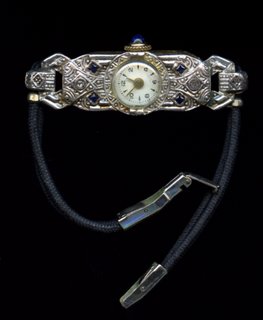
It was yesterday that Rosemary made an astonishing statement in my direction. “You are not long for this world. You live in the past. You tell me what your mother (her watch given to her by my father, right) would have done. Everything was perfect then. It is all wanting now. You are most unhappy now. There is no sense for you to go on in such a state.” I was left speechless. I thought about it quietly. I thought about the past and about time.
It was around 1984 that I wanted to begin to write when I received a most important piece of advice from my friend and writer Les Wiseman. He told me, “You never begin a story from the beginning. You start somewhere in the middle and then work yourself both ways." This has served me well as it seems that most people wanting to tell a story and put it on paper invariably begin at the beginning. Time for them, as it is for most of us, is linear.
Without wishing to tell Rosemary that she is entirely wrong about my scrutiny into my past, I would like to clarify if not correct that my concern is a constant back and forth assessment on how the past put me into the present and how a backward glance might just reveal a forward path.
I do believe that as a human I like to maintain a sense of order. I want to know where things came from and where they are going. If I had a friend who disappeared in my past and almost in my memory I would like to pin my friend down, analyze why we are no longer friends (distance, physical separation). I try to locate my erstwhile friend, renew the friendship if possible or at the very least be able to neatly close the drawer.
It was sometime around 1988 when I went to Buenos Aires for the first time since I had left in 1966 after finishing a two year stint as a conscript in the Argentine Navy. I rang the bell at the home of Susy, an ex-girlfriend I had last seen in 1966 (was madly in love with her) and managed to survive her instruction, "Alex aren't you going to kiss me?" When she died of cancer a few years back I closed her drawer even though memories persist and are there to call back on demand.

Going to my St. Ed's High School reunion this June will put me into the same mode of looking back and pushing forward at the same time. I will study the bond my classmates shared for those four years we boarded in the great neo-Gothic building. Perhaps I will not have anything in common with the dentist, the lawyers, the funeral director, the adobe brick factory owner, the rice farmer, the bean counter who denies ever to have worked for the CIA, the contractor who profits from Texas coast hurricanes, the cowboy rancher who raises quarter horses, the NASA physicist, the PHD in nuclear energy, and the memory of my friend who in a Catholic school had the audacity to proclaim his belief in no God.
If nothing arises from the reunion I will at least be able to again enjoy when I chat with my ex-religion and saxophone teacher, Brother Edwin Reggio, CSC, the unlikely occurrence that back in 1959 I would have never considered (had I looked into the future as my Rosemary suggests I do more often) that some day he, Brother Edwin, and my 10-year-old granddaughter Rebecca would sit next to each other and bite into a huge plate of Texas barbecue.
Time plays a curious game when we temporarily lose our sense of linearity. I had first learned about Einsteinian time in 1963 when my physics professor Chicurel told us the story of the two trains going in the same direction. In 1964 in my train leaving from the Retiro station in downtown Buenos Aires, I happened to glance out of the window and noticed that another train was leaving in the same direction. For a while it looked like both trains were not moving even though I could feel the vibration under my feet and hear the clickety-clack of the wheels. Then the other train accelerated and it seemed we were going backwards. I was amused as I considered that time was not what it seemed.

Since I was lucky enough to not be assigned to an Argentine naval base (the Argentine Navy prized my ability to translate English into Spanish) it meant that I had to pay for my lodgings in the Beccar (a suburb of Buenos Aires) home of a retired Nazi officer. The food was good, the price was right and I kept to myself. Knowing I needed funds one of my sailor mates, Victor Corrales (standing behind me in the photo above, asked me if I were willing to work with him as a waiter weekends in a cantina (bar that served food and had musical entertainment) in the legendary area of Buenos Aires, La Boca. The joint was called Paquebot Priano. The picture shows three of my Argentine Navy sailor mates, all dressed in black and three US Marines who worked with us at the Senior US Naval Advisory Group. It was after working until the wee hours of the morning that I would ride the train back to Beccar. One day, I will never forget, I fell asleep on the bed I was so tired. When I woke up it was late afternoon of the next day. It was six o'clock. I felt a bit tired but ultimately after a coffee I was refreshed. It all vanished when I noticed that the light was acting strangely. It was getting lighter not darker. That's when I knew it was six o'clock in the morning and that I had only slept at the most two hours.
Time (its ravages) is most evident when I go into my photo files and noticing how some of my photographs are stained (bad fixing and time accelerates the staining) or how I must labour at getting the colour right when I scan old colour negatives. But time seems strange when Rosemary and I file old family photographs, "Alex they will appreciate it when we are gone."
What that really means, and I will not mention it at all to Rosemary, is that we will be helping our daughters and granddaughters to explore their past, our past and what remains of our future.
The Magical Filipino Timex

Marking Time
Astern there was a closed door that he had never breached. From that place now came, very loud, a ticking, multiple and unsynchronized...After much hesitation, he made up his mind. He used the butt of his musket, broke the lock and entered...Clocks. Water clocks, sand clocks, solar clocks propped against the walls, but especially mechanical clocks arrayed on various shelves and chests, clocks moved by the slow descent of weights and counterweights, by wheels that bit into other wheels....
It may seem incredible - to you who read this with detachment - but imagine a castaway, amid the fumes of aqua vitae, on an unhabited vessel, finding a hundred clocks almost all in unison telling the tale of his interminable time; he must think of the tale before thinking of its author. And this is what Roberto did as he examined those toys one by one....The clocks were functioning, thus someone must have set them in motion, even if their winding had been designed to last a long time. And if they had been wound before his arrival, he would have heard them already, passing by that door.
...On the ship an intruder did exist.
He had entered the room and had wound the mechanisms. Why he had done so was the first but less urgent question. The second was where had he then taken refuge.
From "The Island of the Day Before", Umberto Eco, 1994
|































